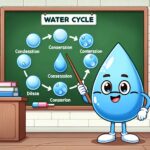Are you prepared to be astounded by condensation’s marvels? Anticipate an exploration of a realm replete with intriguing particulars and noteworthy insights as we decipher the enigmas surrounding this extraordinary procedure. This article is for anyone who enjoys discovering the marvels of the natural world, including inquisitive learners, seasoned scientists, and all others. Embark on an intellectually stimulating exploration of the remarkable and astounding truths pertaining to condensation that will astound you. We will investigate everything, from the underlying physics to the mesmerizing artistry it produces. Thus, fasten your seatbelts and get ready to be mesmerized by the intriguing realm of condensation!
Fun Facts About Condensation
Constraint is an intriguing inherent phenomenon that transpires incessantly, molding our surroundings and exerting an impact on a multitude of facets of our routine existence. We shall now delve into some intriguing condensation facts that will surely astound you with their mesmerizing nature.
1. The Scientific Basis for Dewdrops:
Have you ever pondered how dewdrops form in the early morning on grass and leaves? Everything is due to condensation! The decrease in temperature of the ambient air during the night sky results in the dissipation of energy from water vapor in the atmosphere. The water vapor is converted to liquid water droplets as a result of this energy loss; these droplets adhere to cool surfaces such as leaves and vegetation. As a source of water, these minuscule dewdrops are not only aesthetically pleasing but also essential for plants and animals.
“Next time you see dew glistening on a leaf, remember that it’s the result of a magical chemistry between air temperature and water vapor.”
2. The Inception of Cumulus:
Additionally, condensation gives rise to clouds, those delicate tufts of material that adorn the atmosphere. As balmy air containing water vapor ascends into the cooler upper atmosphere, it undergoes a process of cooling until it becomes incapable of retaining the entire quantity of moisture. Cloud droplets are formed when excess water vapor condenses around minute particles in the atmosphere. As these particles coalesce, they generate clouds of varying dimensions and forms, which adorn our vistas with aesthetic appeal and motivation.
“Clouds are the dreams of water vapor floating and dancing in the sky for all to admire.”
3. Condensation Measuring Instrumentation:
How do researchers quantify condensation? Hygrometers and psychrometers, which are cutting-edge instruments, are utilized to determine the amount of moisture in the air. Hygrometers quantify the relative humidity, or water vapor concentration, whereas psychrometers assess both temperature and humidity. For industrial applications, including climate control and refrigeration, and to enable meteorologists to develop precise weather forecasts, these instruments are indispensable.
“With hygrometers and psychrometers, scientists unlock the secrets of moisture in the air, leading to better predictions and control over our environment.”
4. Condensation and Practical Implementations:
Unbeknownst to you, condensation serves a crucial function in a multitude of industries. Refrigeration is among its most significant applications. Water vapor condenses on frigid surfaces within a refrigerator when warm air comes into contact with them; this process eliminates heat and preserves the freshness of the food. Distillation, an additional significant procedure, separates mixtures of liquids by utilizing condensation to purify substances such as alcohol or water. Furthermore, researchers are investigating fog harvesting methodologies that leverage condensation to extract water from arid regions, thereby offering a significant hydration resource.
“Condensation is not just a natural spectacle; it’s a valuable tool that keeps our food cold, purifies substances, and quenches the thirst of those in dry lands.”
5. The Adaptable Secrets of Nature:
Condensation is not only utilized for diverse purposes by humans, but certain plants and animals have also developed adaptations to strategically exploit this phenomenon. Desert-dwelling insects possess body surfaces that are uniquely engineered to facilitate the collection and storage of atmospheric water vapor, thereby serving as an essential hydration source in arid environments. Specific types of plant foliage possess minuscule formations that facilitate condensation, enabling them to collect and direct water molecules in the direction of their roots. These extraordinary instances illustrate how organisms have utilized condensation as a means of ensuring their survival.
“Nature is a master designer, utilizing condensation in ways that astonish and inspire us.”
In summary, condensation is an intriguing and multifaceted phenomenon that perpetually impacts our environment. The phenomena of condensation are truly remarkable, ranging from industrial applications to the ingenious adaptations of nature and the formation of dewdrops and clouds. Therefore, the next time you observe condensation on a leaf or the clouds above, pause momentarily to acknowledge the remarkable scientific principles that underlie these commonplace phenomena.
Condensation is a miraculous interplay between air, water, and temperature that continues to reveal the secrets of our world. It is not merely a scientific phenomenon. Continue your pursuit of knowledge and investigation into the splendor of condensation.
“The wonders of condensation are everywhere, just waiting to be discovered and celebrated.”
A remarkable phenomenon within the water cycle is condensation. Are you aware that clouds are composed of water molecules in the atmosphere that assemble? Condensation ultimately leads to the discharge of moisture from these clouds, which subsequently produces precipitation. Visit our page on interesting facts about condensation and the water cycle if you are interested in learning additional intriguing information. You will not be let down!
FAQ
What are the origins of condensation?
Condensationd when water vapor cools and comes into contact with the low temperature of the atmosphere, causing condensation to occur.
What function does condensation serve in the formation of clouds?
Condensation is an essential component in the formation of clouds. Water vapour condenses into ice crystals or water droplets as it cools and ascends in the atmosphere; these particles then coalesce to create clouds.
How does condensation become quantified?
Condensationy condensation by employing instruments such as hygrometers and psychrometers. These instruments quantify the relative humidity of the atmosphere, serving as an indicator of the extent of condensation.
Which industries utilize condensation in the following ways?
Condensation finds utility in diverse industrial sectors, including fog harvesting, distillation, and refrigeration. Fog harvesting utilizes it to extract water from fog, while distillation processes employ it to separate liquids with varying boiling points and refrigeration systems to chill and dehumidify the air.
Can any animals or vegetation be identified that have utilized condensation as a source of water?
Yestain plant and animal species have developusingthe ability to utilize condensation as a water source. As an illustration, specific insects that inhabit arid regions possess specialized appendages that enable them to gather moisture from condensation in foggy surroundings. Certain plant species have developed leaves that have the ability to capture and direct condensation in order to supply moisture to their roots.
- Unlocking 2-Letter Words with U: The Definitive Guide - April 4, 2025
- Unlock Words with the Letters THREE: Top Unscramble Tools 2025 - April 4, 2025
- Master Scrabble: X & Z Words for High Scores - April 4, 2025
















